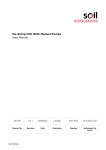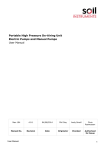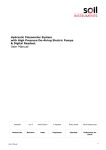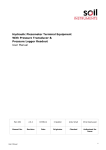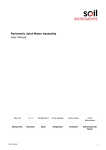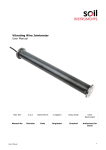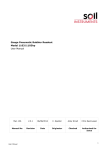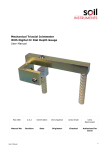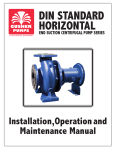Download MAN-165 Twin Cylinder De-Airing Unit
Transcript
Twin Cylinder De-Airing Unit User Manual Man 165 3.0.1 06/08/2014 C.Spalton Andy Small Chris Rasmussen Manual No. Revision Date Originator Checked Authorised for Issue User Manual 1 Contents Section 1 : Forward......................................................................................................... 3 Section 2 : Introduction .................................................................................................. 4 Section 3 : Installation Of The De-Airing Unit ................................................................. 5 Section 4 : Preparation And Setting Up ........................................................................... 6 FIGURE 1 .......................................................................................................................... 6 Section 5 : Operating And Recharging............................................................................. 8 Section 6 : Calculation Of De-Airing Pressures For Piezometers ...................................... 9 Section 7 : Calculating De-Airing Water Volumes .......................................................... 12 Section 8 : The De-Aired Water Boiler ........................................................................... 13 FIGURE 2........................................................................................................................ 13 User Manual 2 Section 1 : Forward It is essential that the equipment covered by this manual is both installed and operated by competent and suitably qualified personnel. They must both READ AND UNDERSTAND the procedures outlined in this manual before attempting installation or operation of the equipment on site. All systems are designed to operate consistently under normal field conditions but although their components are relatively robust for such sensitivity they will not survive mishandling or neglect. Treat all items with respect and handle with CARE. Obviously these techniques can only serve as a general guide and will require modification to suit particular circumstances on site. If difficulties are encountered time will usually be saved by contacting Soil Instruments at the earliest opportunity. User Manual 3 Section 2 : Introduction The de-airing unit consists essentially of a pressure and a supply tank and a gauge to measure water pressure during circulation of de-aired water. All these components are mounted on a frame or panel complete with valves and connecting pipework. Pressure and vacuum pumps are used to operate the equipment. Pressure is applied to the de-aired water in the supply tank by forcing water from the pressure tank into the bladder in the supply tank. Water from the supply tank may then be circulated through the tubes. The volume changes measured in the pressure tank indicates the quantity of water circulated through the system. The equipment has been fully tested to the operating pressure and vacuum before despatch. However, it is possible that movements during transit may disturb the cylinders, pipework or valves sufficiently to cause small leaks when the equipment is operated. If any leaks are observed during operation they should be eliminated by gently tightening the appropriate component. NEVER modify the arrangement without the full written approval of Soil Instruments as unauthorised modifications may bypass the safety system. It is advisable to drain water from the equipment during cold weather to prevent damage to the cylinders due to freezing. WARNING If an anti-freeze solution is used, the system must be flushed with clean water to prevent the bladder from perishing over time. WARNING External high pressure gas cylinders must not be connected to this de-airing unit. User Manual 4 Section 3 : Installation of the De-Airing Unit The unit should be mounted vertically and level either on wooden battens fixed to the instrument house wall, at a convenient height for the operation of all the valves, or stood on a level working surface. The terminal panels should be connected to the elbow connection on the valve marked C on the de-airing unit. Under normal operating conditions the foot pressure pump is connected to the special Schaeder connector on valve A and the foot vacuum pump is attached to valves B and E, as appropriate. WARNING External high pressure gas cylinders must not be connected to this de-airing unit. User Manual 5 Section 4 : Preparation and Setting Up PRESSURE GAUGE K E G PRESSURE CYLINDER J H SUPPLY CYLINDER P L WATER SUPPLY TO INSTRUMENT MANIFOLD VALVE 'S' ON WATER BOILER FIGURE 1 The valves must be operated in the order given, commencing with all the valves in the closed position. 4.1. Attach the vacuum pump with the black hose supplied to valve B. Open valves B, D and E and apply vacuum until the bladder in the supply cylinder is completely evacuated. Close all valves. 4.2. Immerse the red rubber tube into a container of clean water to remove all the air and then attach one end to valve C at the base of the pressure cylinder. Open valves C and B and operate the vacuum pump drawing the water into the pressure cylinder. When this tank is 90% full, close valves C and B. Remove the vacuum hose from valve B, open valve B to release the vacuum, and then close it again. 4.3. Attach the vacuum hose to valve E on the supply cylinder and open the valve. Open valve B and D on the pressure cylinder. Slowly create a vacuum in the supply cylinder using the vacuum pump, this will draw water into the bladder. User Manual 6 When the pressure cylinder is almost empty, close valve D. Remove the vacuum hose from valve E and then close valve E after the vacuum has equalised. 4.4. Connect the vacuum hose to valve B on the pressure cylinder. Attach one end of the red rubber tube to valve S on the boiler and the other end to, valve F on the supply cylinder. Open valves, B, D and F on the de-airing unit and valves S and V on the boiler. (NEVER open valve S before opening valve V with a partial vacuum inside the boiler, as this will draw air into the de-aired water). Use the vacuum pump to draw the water into the cylinder from inside the bladder in the supply cylinder. This draws water from the boiler into the supply cylinder. 4.5. When the pressure cylinder is 90% full, close all valves. Connect the pressure pump to the Schraeder valve (similar to a motorcar tyre inflation valve) above valve A. Open valves A, D and E. Generate a little pressure using the foot pump so that the water in the pressure cylinder is, again, forced into the bladder in the supply cylinder. TAKE CARE! As soon as water comes out of valve E close it and open valve B to release the pressure. Close valve B. 4.6. To completely evacuate the bladder, open valves S and V on the boiler and valves B, D and F on the de-airing unit. Using the vacuum pump, draw the water from inside the bladder into the pressure cylinder, thereby filling the supply cylinder outside the bladder. When the pressure cylinder is 95% full close all valves The unit is now full and ready for operation. WARNING If an anti-freeze solution is used, the system must be flushed with clean water to prevent the bladder from perishing over time. User Manual 7 Section 5 : Operating and Recharging To purge hydraulic equipment of air, carry out the following steps, opening the valves in the order given:5.1. Confirm the pressures to be used to flush the tubes with de-aired water and the volumes required. For overflow cells the pressures required will be very low, for piezometers or settlement cells higher pressures may be required. 5.2. Start with all the valves in the closed position. Fit the foot pressure pump lead to the Schaeder valve on valve A and open valves D, and G. Open/close the appropriate valves on any terminal panel that may be installed. 5.3. Apply pressure gradually so that the level of water in the pressure cylinder slowly begins to fall. Observe the volume changes on the pressure cylinder’s graduated scale. 5.4. As water circulation proceeds the pressure will drop slowly and it will be necessary from time to time to re-adjust it to the original calculated value by operating the foot pump. 5.5. Circulate water until no more air bubbles are seen to be returning through the water in the return lines. Finally check that the volume of water returning corresponds to the volume leaving the de-airing unit. (Volume from pressure cylinder). 5.6. When the flushing operation is complete or the level in the pressure cylinder is almost at the base of the sight glass, close all valves. Open valve B to release any pressure trapped in the pressure cylinder and then close it again. 5.7. During operation of the unit the bladder in the supply cylinder should not be allowed to distend to more than 75% of the volume of the cylinder. At this point it is necessary to recharge with de-aired water as follows: 5.8. Attach one end of the red rubber tube to valve S on the boiler and the other end to valve F on the supply cylinder. Open valves V and S on the water boiler (NEVER open valve S before opening valve V with a partial vacuum inside the boiler, as this will draw air into the de-aired water) and valves B and D on the pressure cylinder and valve F on the supply cylinder. Using the vacuum pump draw the water from inside the bladder into the pressure cylinder, thereby filling the supply cylinder outside the bladder with deaired water from the de-aired water boiler. When the pressure cylinder is 95% full close all valves. The unit is now full and ready for operation again. User Manual 8 Section 6 : Calculation of De-Airing Pressures For Piezometers It is important that pressures used to de-air piezometers are carefully controlled. If too little pressure is applied the de-airing process will take a long time. If too much pressure is applied there may be a risk of hydro fracturing the soil around the piezometer tip. The following calculations would be used to determine a balanced condition from which the send pressure would be increased to generate a steady flow observed in the tubing and in the pressure cylinder. There are many factors that can affect the pressures required to generate a flow and care must be taken not to exert too much pressure on the system without knowing where this pressure is being exerted. Hydro fracture of a soil will create a fissure in the material that could possibly form a drainage path. When a piezometer and its tubing are to be filled with water for the first time, it is very important to slowly and steadily fill the tubes with the minimum pressure required to create a flow. This ensures that all the air in the tubes will be displaced by the water. When de-airing a “Low Air Entry” piezometer tip it may be necessary to initially purge both tubes with water under pressure rather than expecting the water to be sent down one and return down the other. Once a steady flow has been achieved an appropriate volume of de-aired water should be flushed through the tubes and the returned water should be checked for air bubbles. Consider a piezometer tip in the soil during the de-airing process as follows:u p h User Manual = = = pore pressure in the fill at the tip. pressure on the pressure side of the de-airing unit. difference in head between the piezometer tip and the pressure gauge on the de-airing unit. h 9 fAB and fBC = friction losses in the piezometer tube. All pressures are measured with respect to atmospheric pressure. For Equilibrium:p = h + u + fAB Since AB = BC and if no water flows in or out of the piezometer tip, the velocity will be the same throughout the system then fAB = fBC p = 2(h + u) In a piezometer installation h is known and u for each piezometer tip can be estimated using previous pore pressure readings. In this way p can be calculated for each piezometer and de-airing carried out at the appropriate pressure. If the piezometer lies below the readout point, the term h, the difference in head between the piezometer tip and the pressure gauge on the de-airing unit, changes sign and becomes negative. When a piezometer tip has accumulated a lot of air, care should be taken to apply sufficient pressure to drive water at least as far as the tip, prior to applying a vacuum. Where User Manual p = 2 (h + u) p p = = 2 (10 + 5) 30 10 Where User Manual p = 2 (h + u) p p = = 2 (-7 +4) -6 11 Section 7 : Calculating De-Airing Water Volumes After calculating de-airing pressures (see Sections 4 and 5) it is important to determine the volume of de-airing water to be circulated through each instrument. The amount of de-aired water required depends on the length of instrument tubing between the installed instrument and the de-airing unit. Under normal conditions we use tubing with 2.8mm internal diameter and 4.8mm outer diameter (3/16”), 3.8mm internal diameter and 6.4mm outer diameter (1/4”) or 5.4 mm internal diameter and 8.0mm outer diameter (5/16”). The tubing can be installed as two separate tubes, each with a 1mm polythene sheath or as two tubes within a single polythene sheath. 7.1. Determine which size of tubing has been installed by precisely measuring the outer diameter. 7.2. Calculate from installation layout drawings or physically measure the distance from the installed piezometer tip to the de-airing unit. 7.3. Multiply installed length ( in metres x 100 ) by the appropriate cross sectional area in cm2 (0.062 for tubing with 2.8mm internal diameter, 0.11 for tubing with 3.8mm internal diameter or 0. 23 for tubing with 5.4 mm internal diameter) to give de-airing water volume in cubic centimetres ( cm3 ). Add 500cc for the volume of the tip and at least 10% to the calculated volume to allow for tube snaking etc. User Manual 12 Section 8 : The De-Aired Water Boiler Up to 50 litres of de-aired water can be prepared in the boiler at one filling. A heater coil heats the water to boiling thus expelling any air or gases in solution. By sealing the boiler and allowing it to cool, the steam and water vapour above the water condense thus creating a partial vacuum inside the boiler. This prevents further solution of air or gases. 8.1. Open valves V and S. Remove the central filler-cap using the spanner provided. 8.2. Fill with clean water to within 100mm of the top. 8.3. Connect the electrical cable to a suitable mains supply (either 110V or 230V as indicated on the heater coil cover). Switch on at the mains. Bring to the boil and allow to boil for fifteen minutes. Switch off at the mains supply. 8.4. Close valves V and S replace the central filler-cap. Allow to cool. FIGURE 2 WARNING: Although the cap is fitted with a pressure relief valve, NEVER boil with the filler-cap on. With a partial vacuum inside the boiler, NEVER open valve S before opening valve V, as this will draw air into the de-aired water. NOTE : SAFETY REQUIREMENTS: The 4 psi Pressure Relief Valve in the centre of the filler-cap must be checked by a competent person, at intervals not exceeding 12 months. Bell Lane, Uckfield, East Sussex t: +44 (0) 1825 765044 e: [email protected] TN22 1QL United Kingdom f: +44 (0) 1825 744398 w: www.itmsoil.com Soil Instruments Ltd. Registered in England. Number: 07960087. Registered Office: 5th Floor, 24 Old Bond Street, London, W1S 4AW User Manual 13













